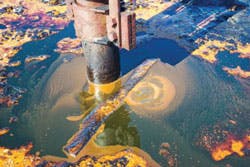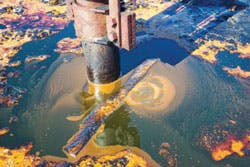Water Briefs
USGS REINSTATES MEASURING WATER USED FOR ELECTRIC ENERGY PRODUCTION
After nearly two decades, the U.S. Geological Survey (USGS) will again track the amount of water consumed in the production of thermoelectric power.
Thermoelectric water withdrawal refers to water removed from groundwater or surface water for use in a thermoelectric power plant, mainly for cooling purposes. Much of the water currently withdrawn for cooling is reintroduced into the environment and immediately available for reuse. Accordingly, the consumptive use occurs when some of the water is evaporated during the cooling process or incorporated into byproducts as a result of the production of electricity from heat. Once the water is consumed, it is no longer able to be reintroduced into the environment.
Tracking consumptive use of this water could allow water resource managers to evaluate the influence it has on the overall water budget of a watershed. As such, the use of heat and water budgets to estimate water consumption at individual thermoelectric plants provides a useful check on other estimation approaches and in many cases may be the most accurate method available.
A USGS report, titled "Methods for Estimating Water Consumption for Thermoelectric Power Plants in the United States," presents updated methods for collecting location and cooling-equipment data. An upcoming study will be released providing the consumption numbers derived from the Survey's heat/water budget models.
The methods for estimating evaporation presented in this study will play a key role in the National Water Census, a USGS research program on national water availability and use that develops new water accounting tools and assesses water availability at the regional and national scales.
THIRD ANNUAL WORLD OF PUMPS QUIZ LAUNCHED
The third annual World of Pumps Quiz was recently launched by ITT's Goulds Pumps brand.
The World of Pumps Quiz is the kick-off activity in an annual program leading to Pump Appreciation Day, initiated by ITT's Goulds Pumps brand and celebrated the second Tuesday in April. Pump Appreciation Day celebrates pumps as "the heart of industry" and features awards for outstanding organizations and individuals in the field, as well as activities to promote heart health.
"We're pleased to give pump industry professionals an opportunity to engage in an event that recognizes the fundamental role that pumps play in modern life and honors those who are making contributions to our industry," said Robert J. Pagano Jr., president of ITT's Industrial Process business, which includes the Goulds Pumps brand. "Last year's quiz was a tremendous success, with an almost 40-percent increase in participants, and we look forward to continuing to build on that momentum in 2014."
The third edition of the World of Pumps Quiz enables contestants to view questions from the first two editions. The latest version also features the advanced Expert Challenge level -- a second set of questions for users who want to test their knowledge to a higher technical degree -- and encourages players to submit their own questions to be considered for future inclusion.
Building on the success of the global pump industry challenge that last year attracted more than 15,000 participants from 151 countries, the quiz runs for 20 weeks, offering new sets of questions biweekly, and ends at midnight on March 30, 2014. To play, visit WorldOfPumpsQuiz.com.
CRAFT BREWERS EYE FAIRFIELD, CA
The city of Fairfield, Calif., has been identified as an ideal location to expand the craft brewery business with its ample water supply, high-capacity wastewater system and available properties with room to grow.
"Fairfield's wastewater treatment plant can handle the high-strength waste that occurs in a brewery's operation, so brew masters do not have to concern themselves with treating the wastewater," said Talyon Sortor, assistant general manager of the Fairfield-Suisun Sewer District. "The district's treatment plant was specifically designed to handle brewery waste because it was built to support the Anheuser-Busch facility located here."
Numerous microbreweries seeking to expand are currently in talks with Fairfield's economic development department. Likewise, the city government is accessible, easy to work with and expedites building permits.
Recently, Heretic Brewing Company moved its operations from Pittsburg, Calif., to an 8,500-square foot Fairfield location that houses a brewery, tasting room and lab space. There are plans to expand in March 2014 to 16,000 square feet in order to conduct more barrel aging and further increase production.
The city has attracted a number of other food and beverage manufacturers, including Anheuser-Busch InBev, Jelly Belly Candy Company, Guittard Chocolates, Frank-Lin Distillers, Sunnyside Farms, and Calbee America.
TECHNOLOGY HELPS RECYCLE TEXAS FRACKING FLOWBACK, PRODUCED WATER
More than 245,000 barrels of flowback and produced water from hydraulic fracturing operations across the state of Texas have been treated as a result of new treatment technologies from Omni Water Solutions.
The HIPPO® mobile water treatment unit -- which includes both ultrafiltration and DOW FILMTEC™ Reverse Osmosis (RO) membrane technologies from Dow Water & Process Solutions -- is being used by a leading operator in Gonzales County to reduce water hardness and boron, and enable reuse of the cleaned water for drilling and fracking operations.
The Gonzales County Operator has been using Omni's mobile treatment unit in a water recycling project to convert produced water into freshwater, brine and hydro-carbon streams. The project's goal is to reduce boron levels from 90 parts per million to less than 5 parts per million in the freshwater stream, thus making it compatible with gel frac formulations and to be reused in subsequent well operations without having to blend in additional freshwater.
After the fracturing process, fluids return to the surface and must be effectively cleaned with advanced treatment solutions to remove high levels of solids, organics and other impurities. Over the longer term, produced water is brought to the surface contaminated with rapidly-changing and difficult-to-remove elements such as calcium and boron from the formation rock. By applying an integrated set of advanced treatment technologies with an automated control system, Omni is able to deliver consistent water quality so operators can reuse produced water with superior results.
The reuse of produced and flowback water is important to oil and gas operators, particularly due to local water shortages and historically dry conditions in the region. Water reuse allows operators to minimize the use and cost of freshwater resources, while reducing complexities surrounding local wastewater disposal and onsite wastewater trucking.
PCB CONTAMINATION DISCOVERED AT SC WATER TREATMENT PLANTS
During a routine sampling at publicly-owned water treatment works in Spartanburg, Greenville and Lyman, S.C., polychlorinated biphenyls (PCBs) -- synthetic chemicals manufactured for use in various industrial and commercial applications -- were discovered.
The South Carolina Department of Health and Environmental Control (DHEC) responded to the discovery of the PCBs in water treatment facilities by issuing an emergency regulation prohibiting the application of sludge to farms or landfills if it has any detectable level of impurities. Previously, such disposal was permitted if the PCB level was less than 50 parts per million.
PCBs were used as coolants and lubricants in electrical equipment before they were banned in 1979 because of adverse health and environmental impacts. According to a PCB background paper prepared by the DHEC, PCBs entered the environment not only during the years when they were being manufactured, used and disposed of, but "PCBs can still be released to the environment from hazardous waste sites, illegal or improper disposal of industrial wastes and consumer products, leaks from old electrical transformers containing PCBs, and burning of some wastes in incinerators."
Contamination was subsequently found on a septage hauler's equipment, Columbia restaurant grease traps, waste oil storage tanks, an oil recycling company truck, and in a stormwater pond. Illegal dumping is suspected, according to a DHEC news release.
One of the treatment plants affected by the PCB contamination, ReWa of Greenville, held a public hearing on Tuesday, Oct. 22, to consider proposed regulations for septage haulers. Among them is the requirement that every hauler will have $1.5 million in environmental cleanup liability insurance in case its equipment is found to be contaminated with PCBs.
Additionally, some local water systems, such as that in Charleston, are notifying restaurants with exterior grease traps that the DHEC recommends that all such traps be locked to prevent illegal PCB disposal.
UNILEVER, U.S. ATTORNEY REACH AGREEMENT FOR CT PLANT POLLUTION VIOLATION
Under the terms of an agreement with the United States Attorney's Office for the District of Connecticut (USAO) and the Environmental Protection Agency (EPA), Unilever USA will plead guilty to two counts of violating the Clean Water Act (CWA) as a result of an illegal discharge of industrial waste at its former Clinton, Conn., manufacturing facility on December 5, 2008.
Accordingly, Unilever will pay a $1 million fine and will also make a $3.5 million charitable donation to the Connecticut Statewide Supplemental Environmental Program (CSSEP), as well as fund various environmentally beneficial projects proposed by the town of Clinton.
Separately, the company reached an agreement with the Connecticut Department of Energy and Environmental Protection (CDEEP) in connection with a civil enforcement proceeding stemming from the incident.
The 2008 occurrence involved two non-managerial wastewater operators who bypassed portions of the facility's wastewater treatment system. While Unilever voluntarily reported the bypass, it did not notify the CDEEP within two hours of becoming aware of the bypass, as required by the facility's discharge permit.
As part of its agreement, Unilever has also agreed to third-party environmental inspections of its manufacturing facilities in the U.S. at least once during a three-year period and will provide a report describing the inspection results to the government. It will also provide basic environmental compliance training to facility employees as well as those outside of the facility who insist on mandatory environmental notifications.
Unilever will also implement certain closure activities at the former Clinton facility.
CAMPAIGN BREWS UP SUPPORT FOR STRONG CLEAN WATER SAFEGUARDS IN MAINE
The Natural Resources Defense Council (NRDC) is partnering with a half dozen craft brewers in Maine to launch a campaign advocating for strong clean water safeguards.
Called "Brewers for Clean Water," the statewide movement was established to help translate the successful economic growth of the craft brewing sector into a powerful voice on behalf of clean water protections in the United States.
Few industries depend on clean water as much as craft brewers. While hops and malt can be sourced elsewhere, breweries are reliant on their local water supplies. Whether drawn from lakes, rivers, groundwater, or a local water system, breweries rely on the protections of the CWA to ensure the quality and availability of their main ingredient (beer is 90 percent water).
In joining the campaign, the brewers take NRDC's "Clean Water Pledge," acknowledging the importance of clean water and clean water safeguards. Further, several Maine brewers called on President Obama to advance long-delayed safeguards under the CWA protecting American streams, wetlands and headwaters (which have a significant impact on larger water sources downstream).
The reach of the craft brewing industry has grown immensely in recent years. With more breweries than any other time in American history, the multi-billion dollar industry brings a compelling business voice to clean water issues.
NANOSENSOR IMPROVES DETECTION OF RADIOACTIVE MATERIALS IN NUCLEAR WASTEWATER
In light of the recent nuclear disaster at Fukushima's Daiichi nuclear power plant in Japan, scientists are reporting progress toward a new way to detect radioactive materials in wastewater, specifically uranium and plutonium.
Highlighted in the American Chemical Society's (ACS) Journal of Physical Chemistry C, authors Jorge M. Seminario and Narendra Kumar discuss the design of a highly-sensitive nanosensor that could help eliminate potential dangers of nuclear disposals and unforeseen accidents.
Seminario and Kumar note that it is highly likely radioactive uranium and plutonium have leaked into the soil and groundwater near nuclear facilities. This contamination poses a serious threat to the environment and human health. Although detecting these materials even at low levels is important for determining whether a leak is occurring, traditional methods of doing so have not proven effective.
Recently however, scientists have discovered that radioactive materials in water can clump onto flakes of graphene oxide (GO). Based on theoretical models and calculations, researchers predicted that GO could sense and identify extremely low levels -- single molecules -- of various substances. Seminario's team set out to see how best to adapt this for uranium and plutonium sensing.
Using the latest advances in supercomputing, they modeled several different variations of GO to assess which one would be the most sensitive and selective in detecting uranium and plutonium in nuclear waste water. They concluded that attaching a carbonyl functional group to GO would serve as an effective nanosensor for these radioactive materials.
ALASKA TO CLOSE CONTAMINATED WELLS, PROTECT GROUNDWATER
A number of motor vehicle waste disposal wells across the state of Alaska are located in state-designated groundwater protection areas and pose a risk to groundwater resources that communities use for drinking water. As a result, the Alaska Department ofADOT&PF used the wells to dispose of stormwater, snowmelt and water used to wash vehicles. This wastewater may have contained antifreeze, brake fluid, waste petroleum, and other vehicular wastes that have known harmful impacts to human health. During vehicle repair and maintenance, these fluids can drip on the floor and enter drains or sinks in service areas. If the drains or sinks are connected to a septic system, dry well or any underground disposal system, chemicals and metals may be entering soil or drinking water supplies.
ADOT&PF has agreed to sample the 55 wells, remove contamination and permanently shut down the wells or convert them to alternate uses by 2018. ADOT&PF is working with the Alaska Department of Environmental Conservation and the EPA to close the wells. Six of the wells have already been closed and the closure process has been initiated for other wells. The result will be better protection for groundwater resources across Alaska.
WA WATERWAY BETTER PROTECTED WITH SETTLEMENT, TREATMENT TECHNOLOGIES
In an attempt to protect the Duwamish Waterway -- the lower 12-mile estuary of Washington State's Green River -- a Seattle industrial firm plans to install new treatment facilities and has paid a reduced fine to settle a penalty issued earlier this year by the Washington Department of Ecology (Ecology).
ConGlobal Industries leases, repairs and maintains shipping containers on the waterway's eastern shore just south of Harbor Island. In a settlement with Ecology, ConGlobal agreed to install treatment technology to remove metal and silt from stormwater that drains to the Duwamish from 23 acres of outdoor industrial areas. The company is scheduled to install an interim treatment system by Nov. 30, 2013, with a permanent system scheduled by Sept. 30, 2015.
ConGlobal has paid $18,000 of the original $35,000 penalty, issued in March. Ecology will dismiss the remaining $17,000 after two years if the company incurs no further penalties and meets the settlement timetable.
Ecology's work with ConGlobal and other nearby industrial firms is part of the Duwamish Urban Waters Initiative, a program established to visit facilities that are potential sources of pollution to storm drains or sanitary sewers, lack environmental permits, or are potential generators of hazardous waste. A technical specialist helps each company identify whether it needs permits or can make voluntary improvements to its environmental practices.
The Initiative supports Ecology's work as a co-manager with the U.S. Environmental Protection Agency of the Lower Duwamish Waterway sediment cleanup site, a 5.5-mile stretch of the Duwamish upstream from Harbor Island. The Initiative also aids in Ecology's priorities of reducing toxic threats and supporting the Puget Sound Initiative, a comprehensive effort by local, tribal, state and federal governments, business, agricultural and environmental interests, scientists, and the public to restore and protect the Sound.
GE TO SUPPLY DESALINATION TECHNOLOGY FOR EGYPT'S LARGEST PETROCHEMICAL FACILITY
Through a $500 million signed technology cooperation agreement, GE Water & Process Technologies and Carbon Holdings have partnered to provide an all-encompassing water desalination plant to Egypt's largest petrochemical facility.
The agreement will support the greenfield naphtha cracker and olefins complex project of the Tahrir Petrochemicals plant in Ain Sokhna, Egypt, and will equip the facility with five of GE's advanced ultrafiltration and reverse osmosis technologies.
As part of the partnership, GE will provide equity financing and advanced technologies to the new petrochemicals complex. This is part of an integrated package of solutions to meet the needs of the country. The technologies to be provided for the new plant include advanced aero-derivatives gas turbines, steam turbines, generators, water filtration and desalination equipment, turbo machinery compressors, and industrial solutions services.The new plant has the potential to drive overall growth of the Egyptian economy with its products having a strong impact on the construction and manufacturing sectors -- two key contributors to the national economy. In addition to direct jobs at the plant, the local availability of the plant's products will also contribute to energizing ancillary industries, thus creating thousands of indirect jobs. With a capacity of 1,360,000 tons per annum of ethylene and polyethylene, as well as significant quantities of propylene, benzene, butadiene, and linear alpha olefins, the plant is billed as the world's largest naphtha liquid cracker.
Featuring a power, water desalination and water treatment plant, the complex will employ a combined cycle power plant to generate 300 MW of power. The full-fledged water desalination plant, featuring GE's proprietary ultrafiltration and reverse osmosis technology, has a generation capacity of 3,800 cubic meters per hour.



